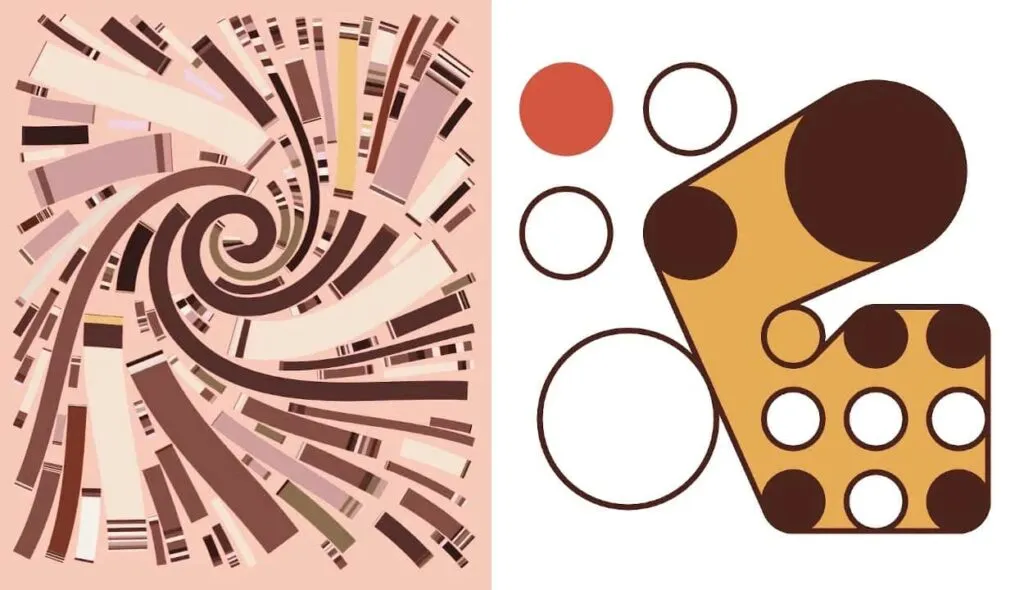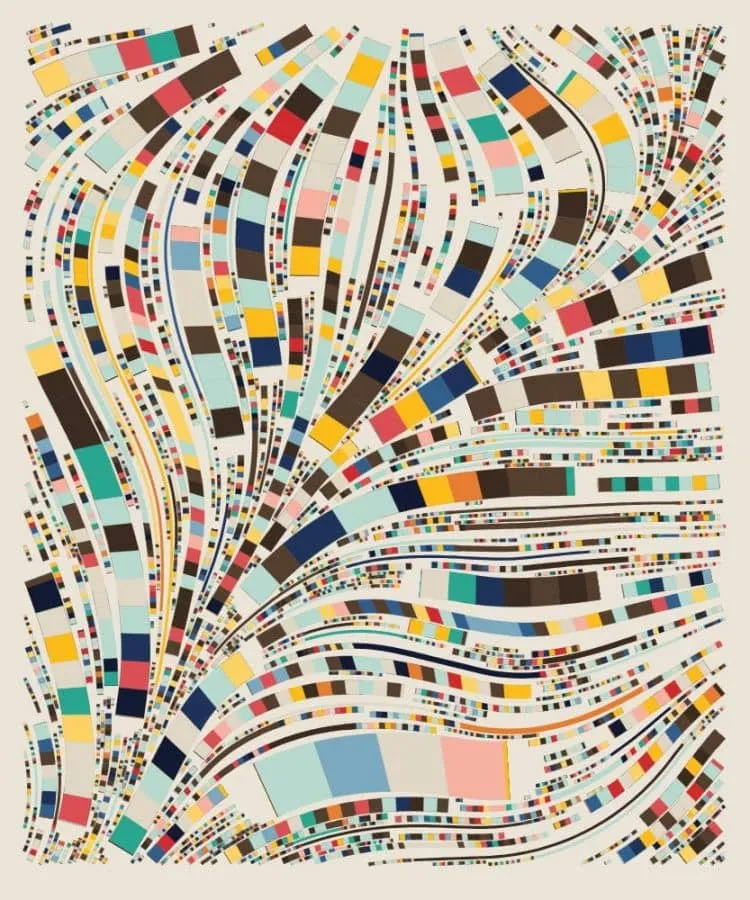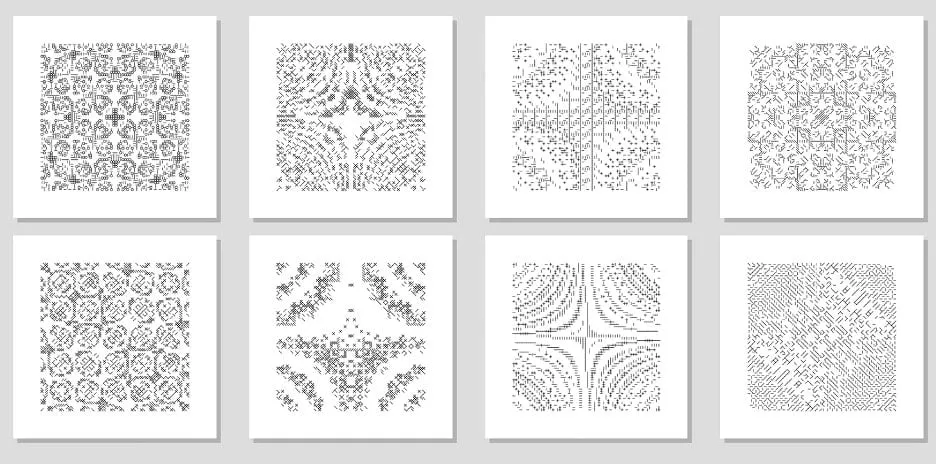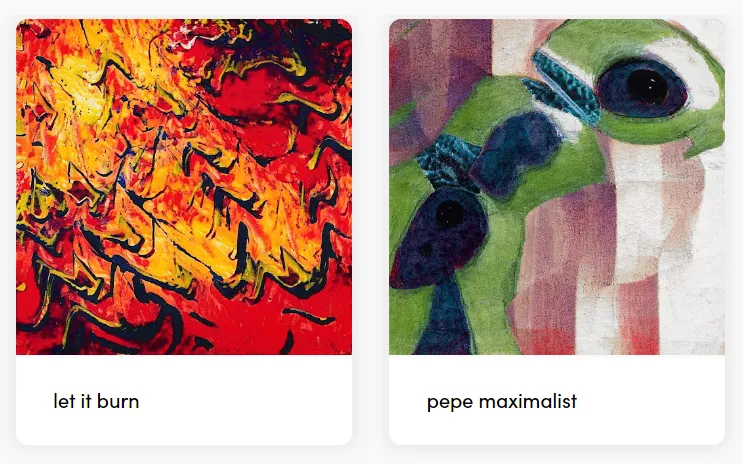Generative NFTs: When Human Creativity Meets Artificial Intelligence

Non-fungible tokens (NFTs) made a huge splash in 2021, with sales of NFTs reaching $25 billion in the same year. NFTs are records on a blockchain that cannot be replaced with something else and retain its value. In that sense, they are different from fungible tokens like bitcoin, which can be traded for another bitcoin and retain the same value. NFTs are most popularly used to sell digital art, by uniquely associating digital assets such as images, videos, music or text to a blockchain record. It is with this association that NFTs promise art collectors to have something that cannot be copied or modified: ownership of the work.
Generative NFTs is a new art genre with a rapidly growing ecosystem within the crypto world that is poised to challenge the traditional art world. Generative art is developed through creative coding and this exciting medium is becoming increasingly popular within the art community, along with those interested in emerging technologies such as artificial intelligence (AI), blockchain and the metaverse. Using a digitally native medium, generative NFTs fundamentally challenge conceptions of what gives art its value and how society expresses its communal values through art.
What are Generative Art NFTs?
Generative art is an expression currently used a lot in the context of NFTs- as a means of ownership, and even a means to create pieces of generative art via smart contracts. The term generative art describes pieces of art that have gone through a generation process by a system that is set into motion with some degree of autonomy contributing to or resulting in a completed work of art. Thereby, generative art can be seen as a collaboration between an artist and an autonomous system. Under this definition, NFTs are not the origin of generative art.
The Origins of Generative Art
Instead, an early example of generative art, more specifically of generative music, is Mozart’s Musikalisches Würfelspiel published in the late eighteenth century. Musikalisches Würfelspiel (German for “musical dice game”) was a system for using dice to randomly generate music from precomposed options. While this is an example of an early piece of generative art, created in traditional manners, blockchain technology enables new opportunities for creation. Generative art can now be created by running a smart contract. A smart contract is code stored on a blockchain under a certain address. By sending crypto to this address, the smart contract is triggered, and the code stored under the address is executed automatically. A piece of generative art will then be created by the smart contract and stored on-chain in the form of an NFT directly owned by the wallet address that sends the crypto to run the smart contract.
Generative Art as NFTs
Today, the common process of creating generative art is by running a machine algorithm, no matter if it is created as an NFT or not. Minting a generative art NFT adds a level of uniqueness that could not have been reached before. This is achieved by including inputs to the piece of art such as wallet address, transaction ID or gas price. These parameters are then used to mint the NFT.
The resulting NFT piece of generative art differs from those art pieces created traditionally. There will always exist only one NFT with these exact parameters. Even if another art piece would be created that looks very similar, the parameters included in the NFT piece of generative art would always be different, and so each piece is truly unique. That said, it is valid to question how the created NFT can be something “special” if the same algorithm could be run millions of times and create NFTs that eventually all look similar, even if they are not identical. But this is an advantage of NFT generative art: a supply cap can be implemented right from the beginning.
Traditionally, the art market has evolved to be exclusive with high entry barriers due to the necessary knowledge and investment size required. The trend towards generative NFT art opens the art market and enables inclusion for people outside of the art scene and with lower investment budgets. This has also been recognized by big players of the art world and thus, auction houses like Sotheby’s and Christie’s put NFTs on their agenda and started curated NFT auctions.
The value of generative art is based on an interplay between embedded attributes with varying degrees of programmatic rarity and how those elements come together in a way that is visually aesthetic and pleasing to the collector. Although the programmatic characteristics add quantifiable metrics that can be used to assist in the valuation of the NFT, generative art pieces still have an element of subjectivity driving demand.
AI-Generated NFTs
Art made entirely by artificial intelligence has been branded as the next big thing and is slowly grabbing the attention of art enthusiasts and NFT collectors all around the world. A collection of NFTs created by a robot artist named Botto sold for over $1.1 million in 2021 and projects like the AI Art House feature generative art NFTs that so closely resembles the likes of Monet, Mondrian and van Gogh that you would be forgiven to mistake them for long lost art pieces by past masters.
AI-generated art is able to produce one of a kind pieces that push the limits of exploration and creativity beyond human touch. Artificial intelligence is commonly understood to be the ability by a non-human model or machine to solve sophisticated tasks and perform human-like cognitive functions such as learning, problem solving, reasoning, and perceiving. When it comes to art, the concept is based on the idea that machine learning algorithms are capable of producing original images when adequately trained using a vast amount of image data using a technology called General Adversarial Networks (GANs). Similar to a painter who has taken years to perfect their craft, AI is also able to learn from endless hours of training and become able to generate images that have never been drawn before.
How this actually works in real life is simple: in order to create a new piece of art, a human artist can simply enter keywords or sentences into an artificially intelligent model that will then use algorithms to analyze millions of works of art and produce its own images as a visual interpretation or representation of the original text. That is the framework behind a tool called Eponym, developed by art platform Art AI, which leverages text-to-art in order to develop AI-generated NFTs. The developer has explained that its algorithms are inspired by “a vast collection of art from throughout history” and that the AI draws inspiration from being exposed to different art genres, periods, subjects and styles to create NFTs from scratch, each with their own distinct style. The result is, according to the developer, otherworldly images of novel styles and contents.
This way, users can easily create a new abstract art piece based on the text they choose and mint it directly to OpenSea. Moreover, single words can only be used once, meaning there will never be two NFTs based on the same text. Eponym allows human touch to be combined with AI algorithms, which has led to some mind-blowing art. And taking it even a step further, a Gen 2 collection of NFTs now allows minters to give sets of instructions to the AI system, including emotions, color schemes, visual styles, and more.
The adoption of AI generative features by artists has been hailed as a new era in art, where the combination of human imagination and AI art based on input text has extended the possibilities of art itself to unknown and yet exciting depths.
Top Generative Art NFT Projects
Developments in the medium and technology have allowed pieces to become more visually complex and appealing, while bringing to life new art genres that human artists have yet to imagine. As the saying goes, art is in the eye of the beholder, and everyone will have their own interpretation, but here are some generative art NFT projects that may catch your eye:
1- Art Blocks
One of the most successful NFT projects on the Ethereum blockchain, Art Blocks is in a class of its own when it comes to active generative art projects. Founded by Snowfro, the platform is built around its Art Node smart contract that allows collectors to mint tokens containing a unique hash string. The thrill of the unknown is part of its appeal as collectors don’t know exactly what their piece will look like until after it has been minted. Art Blocks is the digital platform that produces, sells and stores on-demand generative art, though some people will refer to the art itself as Art Blocks.

You can browse the website exactly as though you were online shopping for a piece of art for your living room. If you find something you like, you can buy it, but instead of being sent a replica of what you chose, an algorithm goes to work making tweaks to the formula, and produces a one-of-a-kind piece in that style just for you. The result is a digital piece of art, which can be anything from an experience, 3-D rendering or cartoon, that can never be copied.
There are three categories of art on the Art Blocks platform: Curated, Playground, and Factory. The Curated section are works chosen by the Art Blocks team as an exemplification of the high level of creativity and execution possible in crypto art. Playground is a space for experimentation and for curated artists to explore what is next for their projects. Individual projects are not vetted by Art Blocks but the artists have been vetted to ensure high quality. The Factory is a sort of anything-goes space. Any artist can submit their pieces to be a part of the Factory and Art Blocks will check to make sure it is functional and not a copy before the piece is published.
Some notable Art Block projects and artists include:
Chromie Squiggles — by Snowfro

Chromie Squiggles was the first-ever collection to be published and minted on Art Blocks. The project is designed by platform founder Snowfro himself. He considers them to “embody the soul of the Art Blocks platform,” and claims they are each his “personal signature as an artist, developer, and tinkerer.” In 2021, a pair of pieces from this collection resold for $4 million.
Fidenza — by Tyler Hobbs

Tyler Hobbs’ colorful project Fidenza is impressive for its ability to generate individual pieces that look incredibly different from one another in color, texture, shape and more. In Hobbs’ own words: “Fidenza is by far my most versatile algorithm to date.” Work from this project has sold for more than $3 million.
Ringers — by Dmitri Cherniak

Ringers features art based on the concept of wrapping a string around a set of pegs. The project uses few colors: black, white and yellow primarily. Cherniak describes the inspiration for his work as “an almost infinite number of ways to wrap a string around a set of pegs. On the surface it may seem like a simple concept but prepare to be surprised and delighted at the variety of combinations the algorithm can produce.” Ringer #109 sold for an astounding $7 million in 2021.
2 – Autoglyphs
Autoglyphs are created using generative algorithms and each artwork is wrapped as an NFT token that contains the original data of the work. The art is inside the smart contract and stored permanently on the Ethereum blockchain. This completely self-contained mechanism for the creation and ownership of artwork earned Autoglyphs recognition as the first “on-chain” generative art project.

Founded in 2019 by the same Larva Labs technologists behind CryptoPunks, the glyphs were originally minted by anyone who was willing to donate the creation fee of 0.2ETH (around $35 at the time) to 350.org, a charity that combats climate change and promotes clean and renewable energies. The creator of each glyph became the first owner of that glyph. After 512 glyphs were created, the generator shut itself off forever and the glyphs are now only available on the secondary market.
Autoglyphs had no human interference in the generation of the artwork. Created entirely by the algorithm to produce ASCII artwork, the project supercharged the NFT industry by becoming the first-ever generative art project on the blockchain and paving the way for the generative art boom today.
3 – Eponym
Eponym is the world’s first and largest collectively created NFT art collection. Developed by Art AI which is the world’s largest gallery of AI generated art, this text-to-art generation relies on algorithms that personalize generative art and that assists users in creating NFTs based on phrases or words of their choice.

Each submission to the minting site takes about a minute to load, but once the AI had completed, you are greeted by a new and unique work of art. Results range from highly abstract, to landscapes and portraits, all depending on the text prompts. Phrases of action creates chaotic representations, locations often produces landscapes with scenery similar to that of its real world appearance, and portraits are mainly born from names of people.
These machine-made artworks represented the project title well, as an eponym is a person for which something is named. In essence, what the team had created was a system where the collector provides the words, or eponym, and is returned a computer generated artistic interpretation bred directly from the AI’s general understanding of the phrase.
The most notable part of the project is that you are able to refresh the algorithm and ask for a new representation of the word or phrase that the creation was born from! This expands the possibilities from one single depiction of a prompt to an endless number, as you could keep rolling until you find the Eponym you want to mint. Once art is rerolled, it would never exist again. The simple permission to allow for a redo opened the door for the collector to have an equal role in the creation alongside the artificial intelligence.
Conclusion: Generating A New Era of Art Appreciation
The generative art NFT movement is leading to greater appreciation of art and inclusion on a global scale. The traditional art world has notoriously become an exclusive club and investment class for the ultra-wealthy to speculate on and flip for profit, or perhaps more nefariously, to launder money or engage in tax evasion.
Although the generative art NFT market may be flooded with euphoric sentiment, early adopters of the movement believe it is ushering in a new digital Renaissance that will enable artists and computer scientists to reach a global audience and experiment with a new medium that is engaging collectors on a deeply emotional level.
Ultimately, the forms and types of art that are produced and highly coveted signals the fundamental values of a society. This is apparent in the values of community-building, inclusion, and mimetic culture. Generative art NFTs have surpassed the traditional art market in its ability to draw attention and capture the imagination of a global audience. (vallartainfo.com) The NFT art community has accomplished this by building an internet-native global community of avid fans, creators, and collectors that do not take themselves too seriously and prioritize fun and connection over physical material possessions.